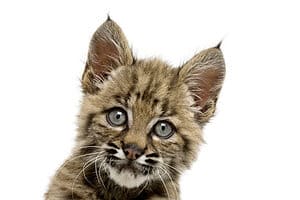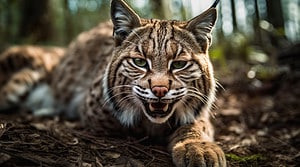Unless you’re familiar with both animals as predators, the instant answer some might come up with in bobcat vs. wild boar might be bobcat. Of the two, many folks would assume a wildcat automatically wins in a fight. Those threatening teeth, the vicious claws; bobcats win, right?
What if you discovered that wild boars are known to be some of the most dangerous animals in multiple states across the USA? Would you reconsider your theory?
Let’s do a side-by-side comparison and discover who really would win in a fight: bobcat vs. wild boar.
Bobcat Vs. Wild Boar Comparison
| Bobcat | Wild Boar | |
|---|---|---|
| Size | 25 to 42 inches long, minus bobtail | 3 to 6.6 feet long |
| Weight | 8 to 33 pounds | 130 to 220 pounds |
| Lifespan | 5 to 15 years in the wild; up to 18 in captivity | Typically 4 to 8 years |
| Diet | Rabbits, hares, rodents, small deer, snakes, lizards, poultry, sheep, coats, domestic pets | Plants of all types, particularly root vegetables and nuts, small rodents, insects, larvae, snakes, birds, carrion |
| Temperament | Shy and reclusive | Aggressive, bold |
| Attack strengths | Teeth, claws, stealth, agility | Tusks, hooves, body girth or weight, muscular strength |
The Key Factors In Determining If A Bobcat or a Wild Boar Would Win in a Fight

Bobcats live in 47 states and wild boars in 28 to 35 (confirmations in at least 28 exist). The two animals aren’t known to tangle often but with the many potential crossovers of territory, the idea isn’t inconceivable. So, the question is, who would win in a fight? The medium-sized wildcat with viciously sharp claws or the bigger, more aggressive boar with tusks and hooves?
The key factors between the two animals could be thought of in two areas: physical advantages and behavior and biology. Let’s look at the differences and see which determining factors would actually create the outcome.
What Is a Bobcat?
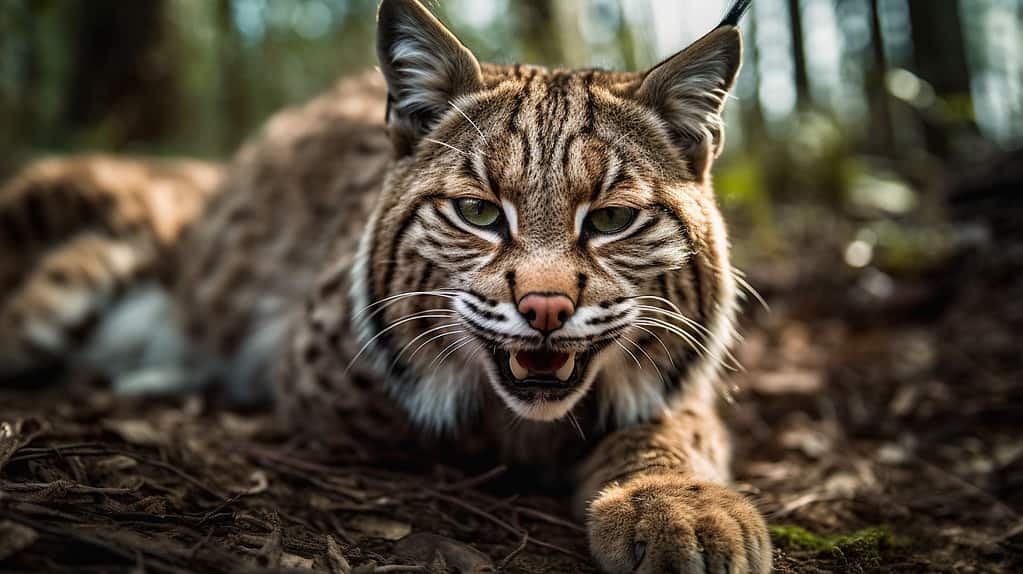
First, it’s important to understand what each species actually is and how they’re built.
The bobcat is a medium-sized wildcat member of the lynx family. Technically, they are still considered “small cats,” though. Usually weighed between fifteen and forty pounds, these cats are predators that rarely make appearances around humans. Highly adaptable, they live in a huge array of habitats, including boreal coniferous mixed forests, bottomland hardwood forests, coastal swamps, scrublands, desert, and even in semi-urban areas on occasion. Bobcats are naturally shy and reclusive, some most folks won’t ever see one in the wild.
Their size lends to bobcats being misidentified by humans unfamiliar with them. Some may think the cats are just large domestic cats; others may mistake bobcats for mountain lions. The wildcats are typically between two to three times larger than house cats, though, and significantly smaller than mountain lions. Additionally, bobcats have naturally bobbed (short) tails while the majority of housecats and mountain lions naturally have long tails.
With brown to blonde fur and dark spots on legs, flanks, and sides, bobcats also have distinctive features in their coloring. Additionally, they have pointed, tufted ears with black spots on the backs. Their hind legs are also disproportionately long compared to their front legs, while the housecat and mountain lion both have proportionate limbs.
What Makes a Bobcat Dangerous?
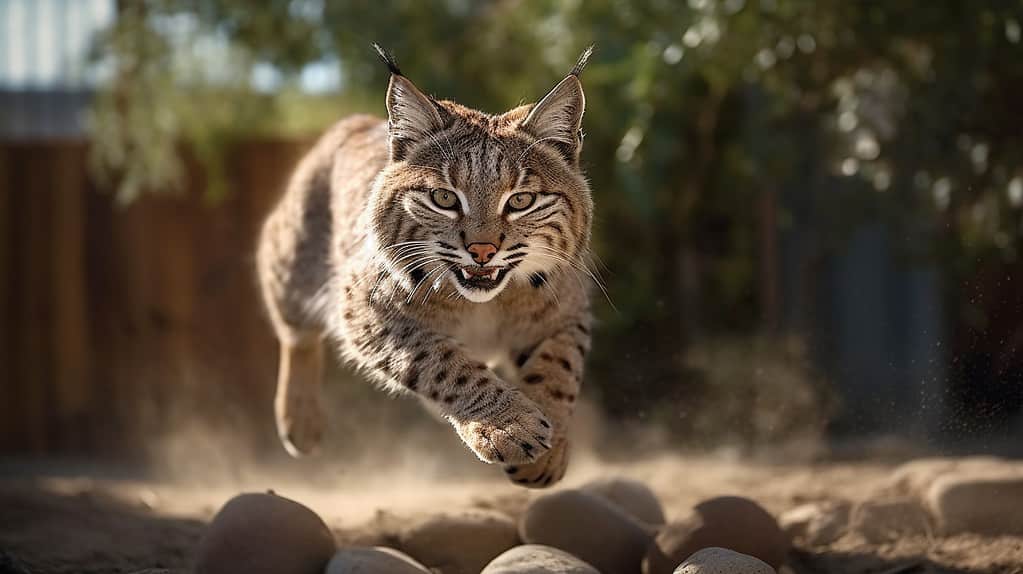
Sometimes called a red lynx, wildcat (think Kentucky Wildcats teams), or bay lynx, bobcats range from southern Canada through the United States down into southern Mexico. These shy, reclusive animals typically avoid high traffic areas, much preferring to roam the forests looking for food and shelter without the interference of humans. Because they’re wildcats, though, many humans tend to think of them as dangerous animals.
The good news for humans, though, is that bobcats rarely interact with humans. They are even less likely to attack a human. Rare instances of rabies (far more common in animals such as raccoons or foxes. If a bobcat does become rabid, or is otherwise unusually aggressive, this is when a bobcat may attack a human. This almost never happens, though.
They are predator animals, however, so they are known to attack domestic animals, livestock, and, of course, other wild animals. Bobcats are responsible for hundreds of livestock attacks annually and so they are dangerous to animals such as sheep, young calves, goats, and chickens.
Their sharp claws, sharp teeth, and lean strength make them dangerous to prey animals.
How Big are Bobcats?
These medium sized lynxes typically weigh between 8 and 33 pounds. They’re usually about the size of a medium-sized breed of dog, with males being larger than females. They typically measure between 25 and 42 inches, minus the bobtail. Bobcats in northern regions are larger than those found in the south.
Do Bobcats Have Predators?
As they are on the smaller side of predators, bobcats do, indeed, have predators of their own. Most commonly these are alligators, mountain lions, coyotes, owls, foxes, wolves, and humans.
What Is a Wild Boar?
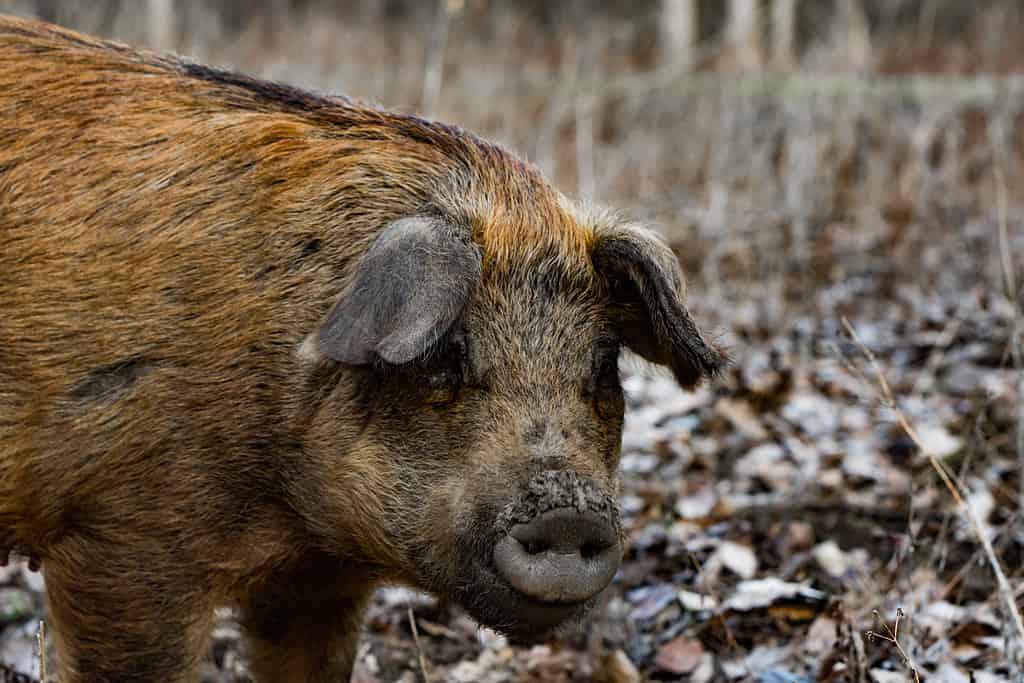
Wild boar go by many names, including wild hogs, feral swine, feral pigs, wild pigs, and feral hogs.
©Marko25/Shutterstock.com
Wild boar, also known as feral hogs, wild pigs, wild hogs, feral pigs, and feral swine, are nonnative animals that have invaded the United States. They live in 35 of the states of the USA, including Hawaii where they famously have become a huge part of the culture.
These mammals are intriguing, for sure, but they’re exceptionally destructive and dangerous animals that frequently destroy vegetation and threaten animals and humans. The wild boars were first brought to the Americas by Europeans as a type of free-ranging livestock for farmers and hunters. However, since they are foragers and highly aggressive, they soon became a dangerous nuisance, breaking free of livestock pastures and farms, private hunting grounds, etc. They’re also prolific breeders, which means their populations have been hard to contain.
These nocturnal animals roam most at nighttime, leaving their shelters in search of food. They spend about 12 hours per day sleeping and the other 12 hours foraging and rummaging. The females of the species typically form sounders in which they raise their young, with between 6 and 30 boars. Sometimes, the groups will share their territory, but usually they’re a bit more spread out. Male boars lea solitary lives except in mating season.
What Makes Wild Boars Dangerous?

Wild boar are highly aggressive animals and don’t always need provocation to attack.
©Ondrej Prosicky/Shutterstock.com
When we hear the word “wild pig” we may be prone to imagining the cute little pot-bellied pigs or the huge, lazy, mud wallowing pigs of cartoonish anecdotes. But wild boars are far more dangerous than either of these appear. They aren’t regularly a threat to humans, with usually only a few attacks reported each year, but they are dangerous animals, nonetheless. They are considered opportunistic predators, meaning they take advantage of weaker animals, penned livestock and the occasional domestic animal, and frequently consume eggs of both wild and domestic birds.
The bigger threat they pose to humans and other animals is the damage they cause to crops and the diseases they carry and spread. Occasionally, though, wild boar attacks may result in hospitalization of humans and on extremely rare occasions, death (usually by trampling or goring injuries and infections).
How Big is a Wild Boar?
Large, bulky, stout creatures, wild boar tend to have thin legs and hulking bodies carried on hindquarters that comparatively seem underdeveloped. Weighing between 165 and 220 pounds on average (males), wild boars grow to about 59 inches long (male) with a shoulder height of about 28 inches.
Do Wild Board Have Predators?
Humans aren’t the only creatures that love a good pork dinner, so wild boars have a number of predators. Among them are alligators, turkey vultures, red-tailed hawks, bobcats (of piglets only), mountain lions, golden eagles, owls (piglets), feral dogs, coyotes, wolves, foxes, bears, ocelots, small Indian mongoose (piglets), and other wild boars.
Which U.S. States Have Bobcats?

Bobcats are cute, wild, and yet ferocious medium-sized cats that live just about anywhere in North America.
©Victor Arita/Shutterstock.com
As noted, all but 3 states in the USA have bobcats living in them presently. This means that every state except Alaska, Hawaii, and Delaware is home to bobcats.
Which U.S. States Have Wild Boars?

Wild boar have fierce tusks that can do some major damage, even when they’re smaller.
©iStock.com/JMrocek
While Hawaii is famous for its many wild boars (and the delicious kalua pork they produce!), 27+ other states in the country have wild boars roaming their woodlands and deserts. Nearly six million wild boar live in the USA.
Most of these mammals live in Oklahoma, Alabama, Florida, Mississippi, Louisiana, North Carolina, Texas, California, Tennessee, Georgia, Arkansas, and South Carolina. Texas has the most with around 3 million wild boars on the loose.
Bobcat Vs. Wild Boar: Biology and Behavior
Since bobcat vs. wild boar fights aren’t frequently on the record, considering the biology and behaviors of both animals is largely from what we draw our conclusions.
Behavior and size, in this case, are the most dominant factors. Bobcats are far more docile and restrained than wild boars. Not prone to aggression and not living in packs or herds like wild boars, bobcats are far less likely to pick a fight with a wild boar.
Wild boar, on the other hand, have their significant girth and powerful hooves, along with their notoriously aggressive behaviors to pull from.
Bobcats may well go after piglets, however, which will provoke the wild boar. Female boars are exceptionally protective over their young, the primary cause for provoking wild boar aggression. However, wild boars are known to attack for no reason, as they simply live out their aggressive natures in the wild. The likelihood of a wild boar randomly charging a bobcat is unlikely, however.
So, Who Wins the Fight? Bobcat vs. Wild Boar?
While some folks might expect the bobcat to be the victor in the battle between bobcat vs. wild boar, the far greater likelihood is that of the wild boar walking away victorious.
The claws and teeth of the bobcat may well cause severe harm to the wild boar, leading to infection and eventual death. However, the sheer size, strength and aggression of the wild boar is the stronger suit for the title of “victor.” A bobcat will, perhaps, feast on piglets, but they are simply not capable of taking down a full-grown wild boar that isn’t already ill or injured. In fact, a bobcat simply doesn’t have the muscular strength to dominate a grown boar. The wild boar will win.
Thank you for reading! Have some feedback for us? Contact the AZ Animals editorial team.





